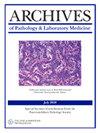解剖病理学中的人工智能民主化。
IF 3.7
3区 医学
Q2 MEDICAL LABORATORY TECHNOLOGY
引用次数: 0
摘要
背景:人工智能是解剖病理学的一项变革性技术。目标:开发一个支持性生态系统,使具有不同人工智能专业知识的病理学家能够在开发环境中创建算法,并无缝过渡到生产环境。由于内部开发需要更长的时间和更多的资源,因此决定使用自动售货机解决方案。病理学家、IT 和安全小组征求并审查了供应商的建议。选定了一家供应商,并建立了开发和生产管道。向病理部门征集开发提案。84 名研究人员被选入初始组群,接受了培训并获得了专门的主题专家的帮助。在 31 个项目中,共有 30 个项目通过了注释、培训和验证等模型开发流程。结论:通过创建一个生态系统来支持具有不同专业水平的病理学家,实现人工智能的民主化,可以打破准入门槛、降低算法开发的总体成本、提高算法质量并加快采用速度。本文章由计算机程序翻译,如有差异,请以英文原文为准。
Democratizing Artificial Intelligence in Anatomic Pathology.
CONTEXT.—
Artificial intelligence is a transforming technology for anatomic pathology. Involvement within the workforce will foster support for algorithm development and implementation.
OBJECTIVE.—
To develop a supportive ecosystem that enables pathologists with variable expertise in artificial intelligence to create algorithms in a development environment with seamless transition to a production environment.
DESIGN.—
RESULTS.—
The development team considered internal development and vended solutions. Because of the extended timeline and resource requirements for internal development, a decision was made to use a vended solution. Vendor proposals were solicited and reviewed by pathologists, IT, and security groups. A vendor was selected and pipelines for development and production were established. Proposals for development were solicited from the pathology department. Eighty-four investigators were selected for the initial cohort, receiving training and access to dedicated subject matter experts. A total of 30 of 31 projects progressed through the model development process of annotating, training, and validation. Based on these projects, 15 abstracts were submitted to national meetings.
CONCLUSIONS.—
Democratizing artificial intelligence by creating an ecosystem to support pathologists with varying levels of expertise can break down entry barriers, reduce overall cost of algorithm development, improve algorithm quality, and enhance the speed of adoption.
求助全文
通过发布文献求助,成功后即可免费获取论文全文。
去求助
来源期刊
CiteScore
9.20
自引率
2.20%
发文量
369
审稿时长
3-8 weeks
期刊介绍:
Welcome to the website of the Archives of Pathology & Laboratory Medicine (APLM). This monthly, peer-reviewed journal of the College of American Pathologists offers global reach and highest measured readership among pathology journals.
Published since 1926, ARCHIVES was voted in 2009 the only pathology journal among the top 100 most influential journals of the past 100 years by the BioMedical and Life Sciences Division of the Special Libraries Association. Online access to the full-text and PDF files of APLM articles is free.

 求助内容:
求助内容: 应助结果提醒方式:
应助结果提醒方式:


